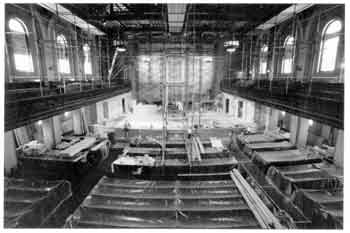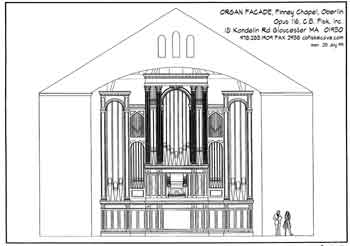by
Linda Shockley
Photo by Ramon Owens

FOR 85 YEARS, AN ORGAN DESIGNED AND built by E.M. Skinner in 1914 and extensively rebuilt by the firm Aeolian-Skinner in the early 1950s, served Oberlin College in Finney Memorial Chapel. That organ has been dismantled (in late-June) and shipped to Indianapolis for renovation before being installed in its new home in Truro Episcopal Church of Fairfax, Virginia.
A new symphonic organ in the romantic tradition, designed and constructed by C.B. Fisk, Inc., acclaimed organ builders of Gloucester, Massachusetts, is scheduled for a summer 2000, installation. In conjunction with the new organ's installation, acoustic engineer Dana Kirkegaard, noted authority in the field of orchestral hall acoustics, will serve as consultant on the project. Following installation, two workers from C.B. Fisk will remain on site for several months to voice the instrument, adjusting the organ's sound quality pipe by pipe.
"A symphonic organ," explains professor of organ Haskell Thomson '58, "is characterized by a virtual rainbow of tone colors, with a dynamic range extending from the softest flutes and strings, to the most powerful foundations and reeds; an instrument capable of making a crescendo from the most ethereal pianissimo to a thundering fortissimo. As a result of this range of sonorities, it is possible for the performer to communicate music to listeners with dramatic impact. Such an organ partakes of both the sonic and the aesthetic worlds of the symphony orchestra and the opera."
The organ will be an ideal instrument for the performance of 19th and 20th century repertoire, particularly French romantic literature, and will complement existing Conservatory organs and the repertoire they serve. The Flentrop (1974) in Warner Concert Hall, given by Frank Van Cleef in memory of George Whitfield Andrews, was designed and built in the northern European style of the 18th century. The Brombaugh organ in Fairchild Chapel (1981), given in memory of Mary McIntosh Bridge '08, was modeled on the late Renaissance/ early Baroque style of northern Europe.
"Both of these organs," says Thomson, "have brought distinction to Oberlin's organ department; in fact, Arthur Wills in a recent book, The Organ (part of Yehudi Menuhin's Music Guides), refers to the little organ in Fairchild Chapel as 'the most outstanding organ yet built in the 20th century.' These organs serve the music of the periods and styles for which they were intended, with great integrity."
The cost of the new organ - $1,185,000 - is made possible in a large measure by a 1991 bequest by Fort Lauderdale philanthropist, Kay Africa. Her bequest in excess of $500,000 stated, "the organ to be designed and constructed by the college as soon as the Fund had grown large enough to pay the cost, shall be a monumental organ of impeccable workmanship and tonal magnificence, which will be worthy of the college's unique, international reputation as a center for the education and training of excellent young organists." That bequest has been augmented by interest garnered from her gift, plus gifts from others including Richard Connelley '50 and the Phoebe Haas Foundation.
David Boe, professor of organ and former dean of the Conservatory, describes this new addition to the College collection, "Oberlin boasts a long and distinguished history in organ performance and education. The new Fisk organ will become the capstone of a superb collection of instruments designed and built to reflect as closely as possible the most important of the historic organ building traditions. The repertory for the organ is the largest of any musical instrument and covers a vast array of styles, more than can be accommodated by any single instrument. Oberlin students will benefit enormously from their experience with these contrasting instruments."

The Fisk organ will retain much of the existing façade and case-work, part of Cass Gilbert's original architecture for Finney Chapel. It will be integrated in the case of the new Fisk organ, augmented and adjusted to be in a style more typical of a French romantic instrument. The organ will draw on the tradition of master-builder of the 19th century, Cavaillé-Coll, remarkable for his vast tonal palette. The keydesk, controlling a mechanical action, will be housed in the organ case above the stage, alleviating current staging problems.
C. B. Fisk, Inc., a firm that has had much success in designing organs for concert halls, was chosen to build this instrument. Fisk is responsible for many prestigious recent projects, including the McDermott Concert Hall at the Meyerson Symphony Center in Dallas, Texas, Yokohama Minato Mirai Hall in Japan, and Benaroya Hall, the home of the Seattle Symphony. Because of the heavy demand for Fisk instruments, the company has a backlog of orders resulting in a five-year waiting period.